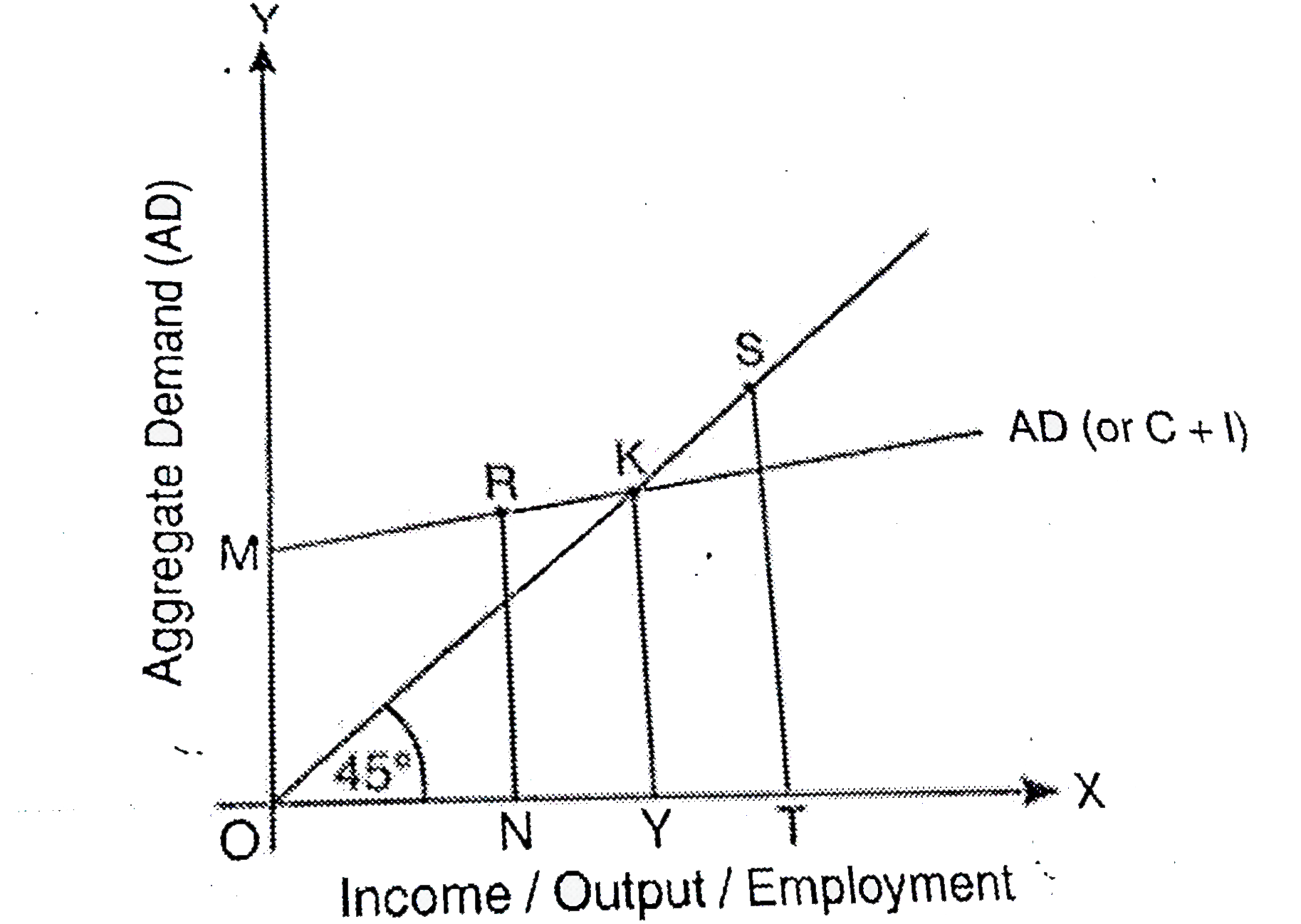Why must aggregate demand be equal to aggregate supply at the equilibrium level of income and output? Explain with the help of a diagram.
According to Keynes , the equilibrium is reached only when aggregate demand (AD) equals aggregate supply (AS) because at this level , there is no tendency for income and output to change.

In the diagram equilibrium is at K where AD intersects 45∘ line. At this point , AD= AS
When AD is more than AS (say, at point R) , then the planned inventory would fall below the desired level. To bring back the inventory at the desired level, the producers expand the output. More output means more income. Rise in output means rise in AS and rise in income means rise in AD. Both continue to rise till they reach K, where AD=AS.
When AD is less than AS (say, at point S) then planned inventory rises above the desired level. To lear the unwanted increase in inventory, firms plan to reduce the output till AD becomes equal to AS.
So equilibrium takes place only at point K, when AD=AS.
Topper's Solved these Questions
- INCOME DETERMINATION AND MULTIPLIERBOOK - SANDEEP GARGCHAPTER - INCOME DETERMINATION AND MULTIPLIEREXERCISE - TRUE AND FALSE
12 Videos
- INCOME DETERMINATION AND MULTIPLIERBOOK - SANDEEP GARGCHAPTER - INCOME DETERMINATION AND MULTIPLIEREXERCISE - SHORT TYPE
11 Videos
- INCOME DETERMINATION AND MULTIPLIERBOOK - SANDEEP GARGCHAPTER - INCOME DETERMINATION AND MULTIPLIEREXERCISE - MCQ
20 Videos
- GOVERNMENT BUDGET AND THE ECONOMYBOOK - SANDEEP GARGCHAPTER - GOVERNMENT BUDGET AND THE ECONOMYEXERCISE - Unsolved Practicals
8 Videos
- MEASUREMENT OF NATIONAL INCOMEBOOK - SANDEEP GARGCHAPTER - MEASUREMENT OF NATIONAL INCOMEEXERCISE - Miscellaneous Practicals
16 Videos
Similar Questions
Knowledge Check
When aggregate demand is greater than aggregate supply, inventories.
AFallBRiseCDo not changeDFirst fail, then rise
How does an increase in demand of a commodity affect its equilibrium price and equilibrium quantity? Explain with the help of a diagram.
View SolutionWhen will (a) simultaneous increases and (b) simultaneous decreases in both demand and supply not affect the equilibrium price? Explain with the help of diagrams.
View SolutionMarket for a good is in equilibrium. There is increase in demand for goods. Explain the chain of effects of this change. Use diagram.
Or
How does an increase in demand of a commodity affect its equilibrium price and equilibrium quantity? Explain with the help of a diagram.
Or
How will equilibrium price and quantity be affected when there is rightward shift of demand curve?
View SolutionCalculate aggregate demand (AD) aggregate supply (AS) for all levels and the equilivbrium leveul of income from the given schedule, if the investment is fixed at 20crores:

View SolutionDifferentiate between aggregate demand and aggregate supply.
View SolutionMarket for a good is in equilibrium. There is increase in supply for this goods. Explain the chain of effects of this change. Use diagram.
Or
How will equilibrium price and quantity be affected when there is increase in supply?
Or
Explain the chain effect of increase in supply of a good on its price, supply and demand. Use diagram.
Or
How does an increase in supply of a commodity affect its equilibrium price and equilibrium quantity? Explain with the help of a diagram.
Or
Market for a good is in equilibrium. Supply of the good 'increases'. Explain the chain of effects of this change .
View SolutionExplain the situation of deficient demand in an economy with the help of a diagram.
View Solution
